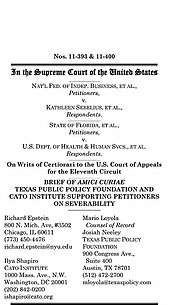Learn more about Cato’s Amicus Briefs Program.
The Obamacare litigation has arrived on the big stage: the Supreme Court. The first opportunity for those opposing the legislation to weigh in comes on the issue that will be the last one the Court considers, “severability.” That is, if the individual mandate is struck down as unconstitutional, what (if any) of the rest of the law must fall with it? On one hand, even in the absence of a severability clause, the Court should avoid striking down an entire law when only one small part is declared unconstitutional, particularly if the remainder of the law is unrelated to the defective bit (imagine an omnibus spending bill). On the other, the Court cannot go provision-by-provision and execute some sort of judicial line-item veto (creating a new law completely unrecognizable from what Congress enacted). Many think that the rules in this area are unclear, but the analysis boils down to two questions: (1) Can the remainder “fully operate as law”? and (2) Would Congress have passed the remainder? In our brief, joined by the Texas Public Policy Foundation and co-authored by Prof. Richard Epstein, we examine these questions with a focus on Titles I and II of the law, which contain all the key provisions relating to Obamacare’s fundamental transformation of the national health care system: the requirement that insurers cover people with preexisting conditions (“guaranteed issue”), the requirement that premiums be assessed by a “community rating” formula, the creation of state insurance exchanges, Medicaid expansion, premium supports, etc. Put simply, knocking out the individual mandate renders this whole package inoperable; the brave new health care world would not work as a matter of basic economic principle. As policy experiments in various states have proven, without an individual mandate, guaranteed-issue and community-rating provisions foster a “death spiral” because healthy people wait until they get sick or injured before buying under-priced insurance that they cannot then be refused, causing premiums to increase and costs to explode. The individual mandate is thus so interwoven with other crucial provisions that it cannot be excised without destroying the entire Obamacare structure. Appreciating this mechanism, the government has conceded that guaranteed-issue and community-rating are indeed inextricably tied to the individual mandate—it has to given its constitutional claim that the mandate is a necessary means of implementing a lawful regulation of interstate commerce—but a close analysis of the law reveals that the interoperability goes much further. And Congress knew this; there is no way it would have otherwise passed this law. Thus, to aid the plaintiffs’ arguments regarding broader non-severability, our brief shows that the individual mandate is so central to the overall legislation that if it falls, those key Titles I and II must go with it.

This work is licensed under a Creative Commons Attribution-NonCommercial-ShareAlike 4.0 International License.



